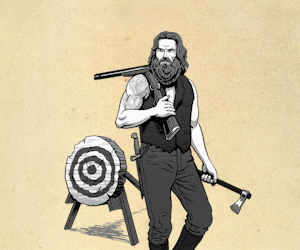Basic knots and knot tying is an ancient art which we’ve largely neglected in the modern era. The whole concept of cordage, how to procure or manufacture it, how to employ it, etc. is a basic survival skill that too many men overlook. You can start a fire, you can pitch a tent, but can you lash together sticks for a lean-to using twine you spun yourself out of fibers from yucca leaves? First things first, you need to know what to do with cordage before you bother learning to make it.
 If you don’t spend a lot of time around boats or fishing, rock climbing/ rappelling, or some kind of rope centric profession or hobby, odds are you know how to tie three or four knots, at best. That’s not enough knots. While a half hitch, a square knot, and your shoelaces can come in handy, they can’t do the work of other well-known and functional knots. Yes, knot tying takes practice, but how many times have you sat at the DMV waiting for your number to come up, staring at the freaks who seem to spend all day there? Drop a one-foot length of paracord in your pocket and read on.
If you don’t spend a lot of time around boats or fishing, rock climbing/ rappelling, or some kind of rope centric profession or hobby, odds are you know how to tie three or four knots, at best. That’s not enough knots. While a half hitch, a square knot, and your shoelaces can come in handy, they can’t do the work of other well-known and functional knots. Yes, knot tying takes practice, but how many times have you sat at the DMV waiting for your number to come up, staring at the freaks who seem to spend all day there? Drop a one-foot length of paracord in your pocket and read on.
Basic terminology of knot tying
First, there are some words you need to know so that the instructions make more sense. When I talk about a running end or a loop, it’s in your best interest to know what that means.
The terms
- Bight: a U-shaped bend in a rope, or a slack length of rope that does not cross itself
- Loop: a bend in a rope that crosses over itself or that at least touches
- Running (Working, Bitter) End: The end of the rope active in tying a knot
- Standing End: The non-working end of a rope, opposite the running end
- Cinch: The act of finishing or tightening a knot
- Hitch: A knot tied around an object
Since this is a 101 article, we’re not going to bother with the terms we won’t use until the next installment. Rope management is one such thing. Suffice it to say, if you’re new at this, you’ll have your hands full with just those.
The Knots
Overhand Knot
An overhand knot is an extremely simple knot. In fact, if you know nothing about ropes or knots, you know how to tie this knot. It is usually used as a stopper. You would tie it at the end of a rope or string to keep something from sliding off the end, or to keep the rope from slipping out of a grommet.
- Make a loop
- Tuck the running end through that loop
- Cinch
Half Hitch
A half hitch is essentially an overhand knot that’s wrapped around something. It’s so simple it only takes a single image to understand. As stated above, hitches are knots that close around things. This one is used to hitch something to a post or tree (or anything else the rope will wrap once around). It’s usually a temporary hitch and it’s easy to untie. It’s also easy to pull loose which is why it’s usually temporary. To make it more permanent you double it up which gives you the clove hitch (below). Another use for it is to add additional security to other knots such as the bowline (which comes later).
- Wrap the rope around the object
- Wrap the running end around itself
Clove Hitch
A more complex hitch that cinches tighter when placed under load. It is either used to hitch one item to another or as a component of another knot. For instance, adding a clove hitch to a bowline makes it a nautical bowline (which is in the next lesson). The clove hitch is not chiral in that you can tie it in either direction.
- Wrap the running end of your rope around an item
- Cross it over the standing end
- Bring it back around the item
- Make a loop which the running end goes back through
- Cinch
Half Knot
A half knot is primarily a starter for other knots such as the square knot or the bow. It’s generally used as a type of loose hitch when used on its own. It requires two running ends.
- Lay one end of the rope over the other
- Wrap it around the other end of the rope
- Cinch
You would ordinarily do this with a rope wrapped around an object.
Square (Reef) Knot
The half knot is the basis of the square knot. A square knot (also called reef knot) is simply two half knots tied opposite each other. It can be used to join two ropes together without sacrificing too much strength. It can also be used to make sure whatever you’re fastening doesn’t come loose. If you pay attention, you’ll notice that this is the basis of tying your shoes.
- Begin with two running ends
- Make a half knot (right over left)
- reverse the half-knot (left over right)
- Cinch
If you do it wrong you’ve made a granny knot which is completely useless. You’ll know when you put it under load because the knot will come undone readily.
Bowline
This is the most complex, but also one of the most useful knots we’ll cover in this lesson. It’s pronounced Bow-Lun instead of Bow-Line, especially in nautical circles. Be aware or you’ll be called a noob. This is the knot you want to tie to keep a loop in a rope that will maintain its size and shape under load. You can use it to tie the end of a yo-yo string, a literal bowline, fasten clasps to a dog or horse lead, hold carabiners, or just about anything that requires a static loop. This is an important knot to practice.
- Begin with a bight
- Make a loop inside the bight
- Pass the running end through the loop
- Move the running end behind the standing end
- Pass the running end back through the loop
- Cinch


















Yeah there are a lot of knots out there but i feel there are only three or four base knots and their variations that you ever really need to use(95% of the time). Knowing how to tie a knot is one thing but knowing how and when to use it is entirely different and takes experience.
Heres the list of knots that i use on a daily basis and rarely have to use any others.
-bowline
-clove
-halt hitch
-fig 8, when i need to tie two ends together really fast that have the same direction of pull its nice. I use this a lot because we are mooring up to piles and ballards in bad weather often. Most people dont.
Yeah those three knots bowline,half hitch, and clove along with different combinations and variations of each are all i ever really use. Fyi if this posts three times my bad. My internet sucks here.
For most people, you’re absolutely right. We’re looking to cover more and application of knots in future articles. Thanks for the comment.
Awesome “101”, and also agree with the above comment. Knowing when to use the right knot is half the hitch (I like dad jokes) experience makes wisdom, knowledge makes the experience a bit smoother, learn the basics and apply. Great article and great comment on some other good knots to learn.